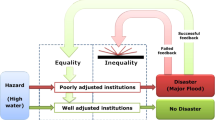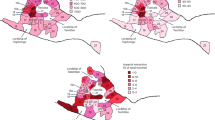Abstract
How wealth is distributed among households provides insight into the fundamental characters of societies and the opportunities they afford for social mobility1,2. However, economic inequality has been hard to study in ancient societies for which we do not have written records3,4, which adds to the challenge of placing current wealth disparities into a long-term perspective. Although various archaeological proxies for wealth, such as burial goods5,6 or exotic or expensive-to-manufacture goods in household assemblages7, have been proposed, the first is not clearly connected with households, and the second is confounded by abandonment mode and other factors. As a result, numerous questions remain concerning the growth of wealth disparities, including their connection to the development of domesticated plants and animals and to increases in sociopolitical scale8. Here we show that wealth disparities generally increased with the domestication of plants and animals and with increased sociopolitical scale, using Gini coefficients computed over the single consistent proxy of house-size distributions. However, unexpected differences in the responses of societies to these factors in North America and Mesoamerica, and in Eurasia, became evident after the end of the Neolithic period. We argue that the generally higher wealth disparities identified in post-Neolithic Eurasia were initially due to the greater availability of large mammals that could be domesticated, because they allowed more profitable agricultural extensification9, and also eventually led to the development of a mounted warrior elite able to expand polities (political units that cohere via identity, ability to mobilize resources, or governance) to sizes that were not possible in North America and Mesoamerica before the arrival of Europeans10,11. We anticipate that this analysis will stimulate other work to enlarge this sample to include societies in South America, Africa, South Asia and Oceania that were under-sampled or not included in this study.
This is a preview of subscription content, access via your institution
Access options
Access Nature and 54 other Nature Portfolio journals
Get Nature+, our best-value online-access subscription
$29.99 / 30 days
cancel any time
Subscribe to this journal
Receive 51 print issues and online access
$199.00 per year
only $3.90 per issue
Buy this article
- Purchase on Springer Link
- Instant access to full article PDF
Prices may be subject to local taxes which are calculated during checkout



Similar content being viewed by others
Change history
28 February 2018
Please see accompanying Corrigendum (http://doi.org/10.1038/nature25992). In the ‘Statistical analyses and graphics’ section of the Methods, the paragraph starting ‘Gini coefficients for Tikal (Classic Maya) and Kahu (Middle Kingdom Egypt)’ has been added, including the associated reference 46.
References
Savoia, A., Easaw, J. & McKay, A. Inequality, democracy, and institutions: a critical review of recent research. World Dev. 38, 142–154 (2010)
Chetty, R. et al. The fading American dream: trends in absolute income mobility since 1940. Science 356, 398–406 (2017)
Scheidel, W. The Great Leveler: Violence and the History of Inequality from the Stone Age to the Twenty-First Century (Princeton Univ. Press, 2017)
Flannery, K. & Marcus, J. The Creation of Inequality (Harvard Univ. Press, 2012)
Fochesato, M. & Bowles, S. Technology, institutions and inequality over eleven millennia. Preprint at https://www.santafe.edu/research/results/working-papers/technology-institutions-and-wealth-inequality-over (2017)
Windler, A., Thiele, R. & Müller, J. Increasing inequality in Chalcolithic Southeast Europe: the case of Durankulak. J. Archaeol. Sci. 40, 204–210 (2013)
Wright, K. I. Domestication and inequality? Households, corporate groups and food processing tools at Neolithic Çatalhöyük. J. Anthropol. Archaeol. 33, 1–33 (2014)
Feinman, G. M. in Cooperation and Collective Action: Archaeological Perspectives (ed. Carballo, D. M. ) 35–56 (Univ. Press Colorado, 2013)
Bogaard, A., Styring, A., Whitlam, J., Fochesato, M. & Bowles, S. in Ten Thousand Years of Inequality: The Archaeology of Wealth Differences (eds Kohler, T. A. & Smith, M. E. ) Ch. 8 (Univ. Arizona Press, in the press)
Taagepera, R. Size and duration of empires growth-decline curves, 3000 to 600 b.c. Soc. Sci. Res. 7, 180–196 (1978)
Earle, T. & Kristiansen, K. (eds) in Organizing Bronze Age Societies 218–256 (Cambridge Univ. Press, 2010)
Borgerhoff Mulder, M. et al. Intergenerational wealth transmission and the dynamics of inequality in small-scale societies. Science 326, 682–688 (2009)
Milanovic, B., Lindert, P. H. & Williamson, J. G. Pre-industrial inequality. Econ. J. (Lond.) 121, 255–272 (2011)
Smith, E. A. et al. Production systems, inheritance, and inequality in premodern societies: conclusions. Curr. Anthropol. 51, 85–94 (2010)
Eerkens, J. W. in The Evolution of Leadership: Transitions in Decision Making from Small-Scale to Middle-Range Societies (eds Vaughn, K. J., Eerkens, J. W. & Kantner, J. ) 73–94 (SAR, 2010)
Lenski, G. E. Power and Privilege: A Theory of Social Stratification (McGraw-Hill, 1966)
Johnson, A. W. & Earle, T. K. The Evolution of Human Societies: From Foraging Group to Agrarian State (Stanford Univ. Press, 2000)
Acemoglu, D., Verdier, T. & Robinson, J. A. Kleptocracy and divide-and-rule: a model of personal rule. J. Eur. Econ. Assoc. 2, 162–192 (2004)
Blanton, R. & Fargher, L. Collective Action in the Formation of Pre-Modern States (Springer Science & Business Media, 2007)
Stone, E. C. in Ten Thousand Years of Inequality: The Archaeology of Wealth Differences (eds Kohler, T. A. & Smith, M. E. ) Ch. 9 (Univ. Arizona Press, in the press)
Smith, M. E., Dennehy, T., Kamp-Whittaker, A., Colon, E. & Harkness, R. Quantitative measures of wealth inequality in ancient central Mexican communities. Adv. Archaeol. Pract. 2, 311–323 (2014)
Wade, L. Unearthing democracy’s roots. Science 355, 1114–1118 (2017)
White, L. A. The Science of Culture: A Study of Man and Civilization (Grove, 1949)
Wilkinson, T. J. et al. The structure and dynamics of dry-farming states in Upper Mesopotamia. Curr. Anthropol. 35, 483–520 (1994)
Styring, A. K. et al. Isotope evidence for agricultural extensification reveals how the world’s first cities were fed. Nat. Plants 3, 17076 (2017)
Sherratt, A. Plough and Pastoralism: Aspects of the Secondary Products Revolution (Cambridge Univ. Press, 1981)
Halstead, P. Two Oxen Ahead (John Wiley and Sons, 2014)
Dong, Y. et al. Shifting diets and the rise of male-biased inequality on the Central Plains of China during Eastern Zhou. Proc. Natl Acad. Sci. USA 114, 932–937 (2017)
Cucchi, T. et al. Social complexification and pig (Sus scrofa) husbandry in ancient China: a combined geometric morphometric and isotopic approach. PLoS ONE 11, e0158523 (2016)
Kim, S.-O. et al. Burials, pigs, and political prestige in Neolithic China. Curr. Anthropol. 35, 119–141 (1994)
Turchin, P. Warfare and the evolution of social complexity: a multilevel-selection approach. Struct. Dyn. 4, 2 (2010)
Cowell, F. A. & Van Kerm, P. Wealth inequality: a survey. J. Econ. Surv. 29, 671–710 (2015)
Xie, Y. & Jin, Y. Household wealth in China. Chin Sociol. Rev. 47, 203–229 (2015)
Davies, J. B., Sandström, S., Shorrocks, A. F. & Wolff, E. N. in Personal Wealth from a Global Perspective (ed. Davies, J. B. ) (United Nations University World Institute for Development Economics Research, 2008)
Iacoviello, M. M. Housing Wealth and Consumption. FRB International Finance Discussion Paper No. 1027. Available at http://dx.doi.org/10.2139/ssrn.1912953 (SSRN, 2011)
Smith, E. A. et al. Wealth transmission and inequality among hunter-gatherers. Curr. Anthropol. 51, 19–34 (2010)
Gurven, M. et al. Domestication alone does not lead to inequality: intergenerational wealth transmission among horticulturalists. Curr. Anthropol. 51, 49–64 (2010)
Shenk, M. K. et al. Intergenerational wealth transmission among agriculturalists: foundations of agrarian inequality. Curr. Anthropol. 51, 65–83 (2010)
Dixon, P. M., Weiner, J., Mitchell-Olds, T. & Woodley, R. Bootstrapping the Gini coefficient of inequality. Ecology 68, 1548–1551 (1987)
Bocquet-Appel, J. P. Paleoanthropological traces of a Neolithic demographic transition. Curr. Anthropol. 43, 637–650 (2002)
Kohler, T. A., Glaude, M. P., Bocquet-Appel, J.-P. & Kemp, B. M. The Neolithic demographic transition in the U.S. Southwest. Am. Antiq. 73, 645–669 (2008)
Smith, B. D. & Yarnell, R. A. Initial formation of an indigenous crop complex in eastern North America at 3800 b.p. Proc. Natl Acad. Sci. USA 106, 6561–6566 (2009)
Lindert, P. H. & Williamson, J. G. Revising England’s social tables 1688–1812. Explor. Econ. Hist. 19, 385–408 (1982)
Smith, M. E. Aztec City-State Capitals. (Univ. Florida Press, 2008)
Calnek, E. E. in Ensayos sobre el desarrollo urbano de México (ed. Borah, W. ) 11–65 (Secretaría de Educación Pública, Mexico, 1974)
Chase, A. S. Z. Residential inequality among the ancient Maya: operationalizing household architectural volume at Caracol, Belize. Research Rep. Belizean Archaeol. 14, 31–39 (2017)
Acknowledgements
Countless archaeologists make comparative work such as this possible. We thank the Amerind Foundation for funding and hosting the workshop resulting in this paper and the volume Ten Thousand Years of Inequality: The Archaeology of Wealth Differences; the Dynamics of Wealth Inequality Project and the Behavioral Sciences Program, Santa Fe Institute; and the Department of Anthropology and the College of Arts and Sciences, WSU. We acknowledge comments from R. Drennan, T. Earle, C. Hastorf, I. Morris, R. Oka, J. Sabloff and C. Szuter. This material is based on work supported by the European Research Council Grant Number 312785 (A.Bo.), the US National Science Foundation Grant Numbers BNS-91-05780 (G.M.F.), SBR-9304248 (G.M.F.), SBR-9805288 (G.M.F.), BCS-0349668 (G.M.F.), CNH-0816400 (T.A.K.), SMA-1620462 (T.A.K.), BCS-0313920 (A.M.P.) and BCS-0713013 (A.M.P.). IDOT and FHWA supported the Cahokia-area project.
Author information
Authors and Affiliations
Contributions
T.A.K. and M.E.S. designed the study; all authors collected and contributed data; T.A.K., M.E.S., A.Bo., G.M.F., C.E.P., A.Be., M.P., E.C.S. and A.M.P. discussed results; T.A.K. analysed the data; T.A.K. and M.E.S. wrote the paper; T.A.K. and L.J.E. prepared the graphics.
Corresponding authors
Ethics declarations
Competing interests
The authors declare no competing financial interests.
Additional information
Reviewer Information Nature thanks M. Elliott and W. Scheidel for their contribution to the peer review of this work.
Publisher's note: Springer Nature remains neutral with regard to jurisdictional claims in published maps and institutional affiliations.
Supplementary information
Supplementary Information
This file contains Supplementary Tables 1, 3-7 and Supplementary References. (PDF 303 kb)
Supplementary Table 2
This file contains data used in the study, sorted by hemisphere and ascending date and also Supplementary Table 2 metadata. (XLS 86 kb)
Rights and permissions
About this article
Cite this article
Kohler, T., Smith, M., Bogaard, A. et al. Greater post-Neolithic wealth disparities in Eurasia than in North America and Mesoamerica. Nature 551, 619–622 (2017). https://doi.org/10.1038/nature24646
Received:
Accepted:
Published:
Issue Date:
DOI: https://doi.org/10.1038/nature24646
This article is cited by
-
Book reviews for the Journal of Economic Inequality
The Journal of Economic Inequality (2024)
-
Stable carbon isotope (δ13C) analysis of archaeobotanical remains from Bronze Age Kaymakçı (western Anatolia) to investigate crop management
Vegetation History and Archaeobotany (2024)
-
Income and inequality in the Aztec Empire on the eve of the Spanish conquest
Nature Human Behaviour (2023)
-
The Later Phases of Southern Mesopotamian Urbanism: Babylonia in the Second and First Millennia BC
Journal of Archaeological Research (2023)
-
Finding the Impact of Market Visibility and Monopoly on Wealth Distribution and Poverty Using Computational Economics
Computational Economics (2023)
Comments
By submitting a comment you agree to abide by our Terms and Community Guidelines. If you find something abusive or that does not comply with our terms or guidelines please flag it as inappropriate.



